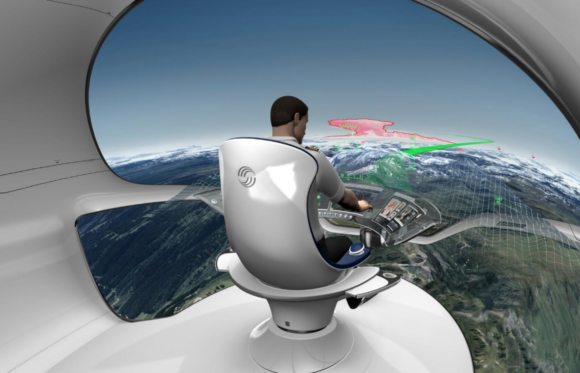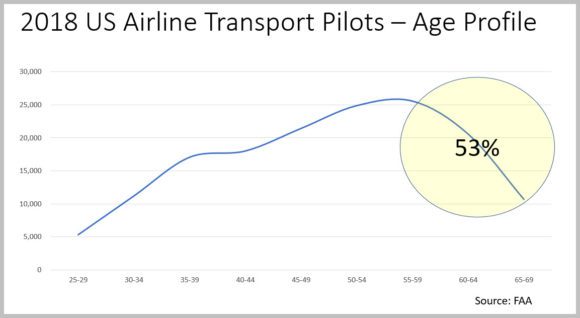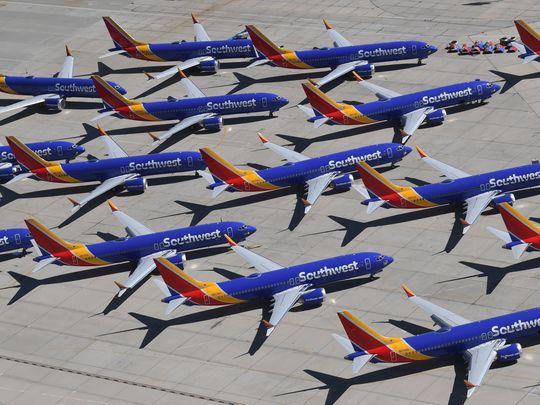Having spent two days last week at the Regional Airline Association annual convention last week, I listened to numerous discussions on the labor shortage issues facing the industry, especially the pilot shortage.
One of the continuing problems facing the regional airline industry is staffing, and the pilot shortage has now exacerbated into both a pilot and mechanic shortage, as the industry is not attracting enough newly trained professionals to meet the needs of a growing industry. The result is that the regional industry is dropping smaller cities and flying larger regional aircraft with fewer frequencies, as they cannot staff the same level of traffic with smaller aircraft.
There are several issues impacting the issue, including cost, keeping instructors, capacity growth, and increasing the pipeline of candidates.
High Cost
Becoming a pilot is a very expensive career aspiration. One major problem is the high cost of training a commercial pilot, mandated by the congressional actions requiring 1,500 hours of flight time, which costs about $200,000 for a student to acquire. When the level was 250 hours, the costs were a more manageable $40,000. With a 4-year aviation university, requirements are lowered to 1,000 hours, and with a 2-year degree to 1,250 hours, but these all come out to be about the same price in the end.
A candidate either needs to come from a wealthy family or faces about $200,000 in debt when he or she starts a job paying less than $25,000 annually. While salary growth is quite rapid once a candidate advances through the ranks, it is nearly impossible for a new right-seat pilot to pay off much debt at today’s salaries, which continues to grow as the supply-demand balance continues to be resource limited. So how can the industry reduce cost and provide financing for those with aspirations to be a pilot?
One mechanism of reducing cost would be re-examining how we perform flight training. Internationally, licenses are being issued to pilots with 250 hours of training who are successfully and safely flying international routes, including some co-pilots with under 400 hours of total time flying wide-bodies into US airspace quite safely. The congressionally mandated increases in training time are totally unrealistic and continue to make aviation unaffordable for many, including women and minority candidates.
Federal legislation is one of the reasons that few women and minorities were present at RAA, and the luncheon appeared to be a collection of 95% middle-aged white males. Attracting women and minorities is an issue that is difficult, and exacerbated by the high cost of flight training, which many minority candidates believe to be simply out of their reach and an unrealistic aspiration. Congress engendered an unintended consequence of keeping minorities and women out of aviation by raising a barrier to entry – high costs.
Under the existing legislation, colleges and universities are capitalizing on their advantage of paying for 500 fewer flying hours when one earns a four-year degree. That is likely a savings of $67,000 in flight time. But the cost of attending the university adds another $100,000 to $200,000 for a four-year aviation degree and takes an additional four years to complete. The candidate who spends the money on flight school and earns his 1,500 hours in a year or two will have a two-year advantage in seniority and income growth over the four-year graduate. The cash flow and promotions, combined with millennials questioning the value of a four-year degree, is making attracting candidates to aviation universities difficult without scholarships, which are not always available.
Costs at colleges have been rising over the last 40 years at higher rates than inflation, and the cost disciplines learned in industry have not found a home in higher education. The resulting inflation in tuition costs has not yet been squarely addressed by most institutions. In walking the exhibits at RAA, one university indicated that their competitive advantage was having the lowest tuition rates, and that competition is the best way to lower high costs. We concur.
Maintaining Flight Instructors and Changing How we Train Pilots
Almost all flight schools find that their cadre of flight instructors has high turnover, as pilot demand is such that offers for higher pay are constant for qualified pilots. As a result, schools and universities must offer benefits to their flight instructors to keep them, at least until they can train their successor instructors, before being hired away. In a four-year university, instructors can be trained and earn money to offset tuition through flight instruction, but ultimately graduate. Without qualified instructors, the flight training process can grind to a halt.
We haven’t changed the way we train pilots in the United States for quite some time. I earned my pilots license in 1971, and the process today is virtually identical, despite considerable progress in aircraft, avionics, and airspace technologies. The stages of Private, Instrument, Commercial, and ATP remain in place, with simply more hours and expense now required for an ATP license. The federal requirements don’t understand that 1,500 hours in a Cessna 172 does not qualify one to fly a regional jet and does not differentiate the quality of the hours of experience, merely the quantity.
Today, procedure trainers and simulators are much more advanced than they were a decade ago, and the advances in information technology and avionics continue to reduce the cockpit workload for a pilot. Rather than more hours, teaching the right techniques is what is important to ensuring that pilots are trained for safe operations. Crew coordination is NOT a requirement for an ATP license, but should be since the interactions of a pilot and co-pilot are critical in an emergency.
We’ve seen problems in Asian airlines of junior officers not contradicting a Captain when he does something wrong to prevent the Captain from losing face to a junior officer. One of these instances resulted in a crash of a Boeing 777 on a beautiful VFR day in San Francisco when the co-pilot failed to inform the Captain that the glide path was too low. While this is quite unlikely to happen in the US, which has a different culture, it serves as an example of the types of problems that emerge that require new processes and technologies.
More practical regulations are what is needed, but the inertia inside the FAA prevents progress. A “yes-Sir Massa” attitude towards Congress to ensure funding levels, rather than clearly laying out the unintended consequences of congressional actions, got us into this problem in the first place. This has resulted in a lack of Part 135 air-taxi operations and virtually no air service to many smaller communities. That’s exactly opposite of what the FAA’s charter states. As one keen observer stated, if pro is the opposite of con, progress is the opposite of Congress.
Training today needs to based on how each individual performs, which tasks they have mastered, and which require further instruction. Computer-based training aids, individualized curricula, and proficiency testing are quite feasible with today’s technology, and can both lower cost and improve pilot skills and safety. But the FAA is missing in action in this battle. The result is lower levels of safety, as our newest pilots may now have 1,000 to 1,500 hours of flight time, but in the wrong aircraft and wrong setting. Gaining the extra 750-1,250 hours in a disciplined and professional airline environment is preferable to building time as a flight instructor in a Cessna 172.
Capacity Growth
We have seen the airline traffic double every 15 years worldwide, meaning that we need to train not only 100% more pilots during that period, but replacing the 1/4th to 1/3rd that will retire over that period. So, for every pilot today, we need to train about 2.5 to meet the needs 15 years from now.
Those pilots are needed at all levels, and the pathway to growth, with the highest levels of turnover and training requirements, are at the regional airline level. Pilots who fly regional aircraft in the US are in high demand because they learn the skills required for safe operations on the job and learn how to lead in emergency situations that demand decisive actions and crew coordination. The regional airlines are the true training ground for pilots and fulfill this role quite well. But the future requirements are daunting, especially with student pilot numbers down.
The industry needs to attract more candidates if regional airlines are going to continue to serve smaller markets with smaller planes. Otherwise, regional operations will migrate upward to 100-130 seat aircraft by 2040 as mainline airlines operate 200 plus seat narrow-body or wide body aircraft. The question we must ask is whether we want air service to smaller communities to continue or go by the wayside. Most of us prefer the former to the latter.
Diversity and Increasing the Pipeline of Candidates
All of us in aviation have a responsibility to be ambassadors for our industry, and to reach out to women and minorities about the opportunities within our industry. The problem we run into when we try is funding. We can find young men and women in the minority community whose heads look up whenever an airplane flies over and aspire to fly. But without a solution to the cost problem, their aspirations appear to be out of reach.
Even though the RAA Convention was about 95% middle-aged white males, that doesn’t mean that women and minorities would not be welcomed with open arms in regional aviation – they would be. The attitudes among airline CEOs, universities, and the industry supply chain is welcoming to women and minority candidates. We would love to see more women and minority pilots and mechanics, as these jobs pay higher than average salaries. But the primary barrier to entry is money. Without scholarships or tuition grants, minority candidates generally cannot afford to aspire to aviation as a career.
The only way to increase the pipeline of qualified candidates for aviation is to match their aspirations with the realism of affordability, which is easier said than done. But not every hour needs to be flown in an aircraft to learn a process or procedure. Once a task is mastered, one can move on to the next skill, irrespective of the hours required to learn it. But that requires regulatory change, and the nearly impossible to overcome inertia at the FAA.
Unions Taking Advantage
Unfortunately, the only industry people not in favor of reform are the pilot unions, as the shortage provides them additional bargaining power. Supporting the ridiculously high hour requirements is harming the industry that feeds the major airlines much of their traffic. Of course, the pilot unions would rather see regional aviation merge into the major airlines, raising costs for the traveling public, to increase their enrollment and power. The major carrier pilot unions, by not speaking out about the requirements or training reform, are doing the industry a disservice.
The Bottom Line:
There are no easy answers when governments remain behind the power curve with outdated and obsolete regulations. But the industry needs to pull together to identify processes that would work to improve the situation and educate both the public and Congress on why their rules are unfair to our citizens, especially the minority communities that they have effectively shut out of an industry and its high paying jobs through artificially inflated costs and barriers to entry. This industry needs and deserves better.
Views: 3




